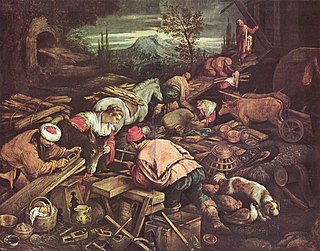Related Research Articles

Japheth is one of the three sons of Noah in the Book of Genesis, in which he plays a role in the story of Noah's drunkenness and the curse of Ham, and subsequently in the Table of Nations as the ancestor of the peoples of the Aegean Sea, Anatolia, Caucasus, Greece, and elsewhere in Eurasia. In medieval and early modern European tradition he was considered to be the progenitor of the European peoples.

Noah appears as the last of the Antediluvian patriarchs in the traditions of Abrahamic religions. His story appears in the Hebrew Bible, the Quran and Baha'i writings, and extracanonically.

Shem is one of the sons of Noah in the Bible.

The Ginza Rabba, Ginza Rba, or Sidra Rabba, and formerly the Codex Nasaraeus, is the longest and the most important holy scripture of Mandaeism.

Mandaeism, sometimes also known as Nasoraeanism or Sabianism, is a Gnostic, monotheistic and ethnic religion with Greek, Iranian, and Jewish influences. Its adherents, the Mandaeans, revere Adam, Abel, Seth, Enos, Noah, Shem, Aram, and especially John the Baptist. Mandaeans consider Adam, Seth, Noah, Shem and John the Baptist prophets, with Adam being the founder of the religion and John being the greatest and final prophet.

The wives aboard Noah's Ark were part of the family that survived the Deluge in the biblical Genesis flood narrative from the Bible. These wives are the wife of Noah, and the wives of each of his three sons. Although the Bible only notes the existence of these women, there are extra-biblical mentions regarding them and their names.
In Mandaeism, Ptahil also known as Ptahil-Uthra, is the Fourth Life, the third of three emanations from the First Life, Hayyi Rabbi, after Yushamin and Abatur. Ptahil-Uthra alone does not constitute the demiurge but only fills that role since he is viewed as the creator of the material world in the Ginza Rabba, often holding an inherently malicious character.
An uthra or ʿutra is a "divine messenger of the light" in Mandaeism. Charles G. Häberl and James F. McGrath translate it as "excellency". Jorunn Jacobsen Buckley defines them as "Lightworld beings, called 'utras ." Aldihisi (2008) compares them to the yazata of Zoroastrianism. According to E. S. Drower, "an 'uthra is an ethereal being, a spirit of light and Life."
The Right Ginza is one of the two parts of the Ginza Rabba, the longest and the most important holy scripture of Mandaeism. The other part of the Ginza Rabba is the Left Ginza.
Mandaean cosmology is the Gnostic conception of the universe in the religion of Mandaeism.
In Mandaeism, Yushamin and also known as the 'Second Life', is the primal uthra and a subservient emanation who was created by the Mandaean God 'The Great Life', hence beginning the creation of the material world. Yushamin is the father of Abatur. Jorunn J. Buckley identifies Yushamin as "both a Lightworld utra beyond reproach and the prototype of a priest who has made mistakes in ritual."
In Mandaeism, Manda d-Hayyi or Manda ḏ-Hiia is an uthra sent by the Great Life as a messenger to John the Baptist. Manda d-Hayyi is considered to be the most important uthra, since he is the one bringing manda to Earth (Tibil).
The Mandaean calendar is a 365-day solar calendar used by the Mandaean people. It consists of twelve 30-day months, with five extra days at the end of Šumbulta. The Parwanaya festival takes place during those five days. There is no leap year therefore every four years all Mandaean dates move one day back with respect to the Gregorian calendar.
The Baptism of Hibil Ziwa or Diwan Maṣbuta ḏ-Hibil Ziwa is a Mandaean illustrated scroll. It describes the soteriological descent of Hibil Ziwa to the World of Darkness, and his baptisms before and after. The scroll is essentially also a commentary on the masbuta, or Mandaean ritual baptism.
In Mandaeism, Hibil or Hibil Ziwa is an uthra from the World of Light. Hibil is considered to be the Mandaean equivalent of Abel.
In Mandaeism, Shitil is an uthra from the World of Light. Shitil is considered to be the Mandaean equivalent of Seth.

In Mandaeism, various beings inhabit the World of Darkness.
In Mandaeism, Shurbai and Sharhabeil were a couple named as the progenitors of the third generation of humans. Shurbai is the husband, while Sharhabeil is his wife.
The following outline is provided as an overview of and topical guide to Mandaeism.
References
- ↑ Utley, Francis Lee (1941). "The One Hundred and Three Names of Noah's Wife". Speculum. 16 (4): 426–452. doi:10.2307/2852842. JSTOR 2852842. S2CID 163797953.
- ↑ Schuller, Eileen (2009). "Women in the Dead Sea Scrolls: Some Observations from a Dictionary". Revue de Qumrân. 24 (93): 49–59. JSTOR 24663086.
- ↑ Häberl, Charles (2022). The Book of Kings and the Explanations of This World: A Universal History from the Late Sasanian Empire. Liverpool: Liverpool University Press. doi:10.3828/9781800856271 (inactive 1 November 2024). ISBN 978-1-80085-627-1.
{{cite book}}: CS1 maint: DOI inactive as of November 2024 (link) - ↑ "Book Nineteen: The Deluge". Ginza Rabba . Vol. Right Volume. Translated by Al-Saadi, Qais; Al-Saadi, Hamed (2nd ed.). Germany: Drabsha. 2019. pp. 203–204. [Note: this book, or a larger text containing it, is numbered book 18 in some other editions.]
- ↑ Gelbert, Carlos (2011). Ginza Rba. Sydney: Living Water Books. ISBN 9780958034630.
- ↑ Lupieri, Edmondo (2008). "The Mandaeans and the Myth of Their Origins". In Macuch, Rudolf (ed.). Und das Leben ist siegreich! / And Life is Victorious. Otto Harrassowitz Verlag. pp. 127–144. ISBN 978-3-447-05178-1.